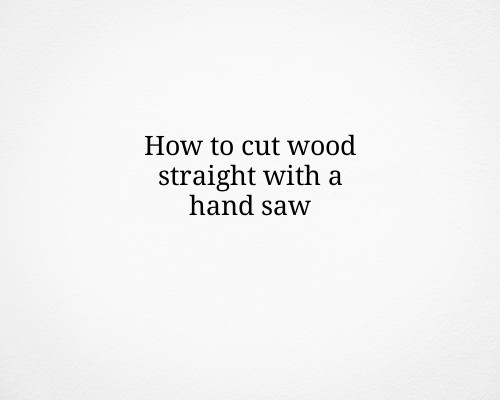Cutting wood straight with a hand saw requires proper technique, the right tools, and a steady hand. Follow these steps to achieve a precise cut:
Tools Needed:
- Hand saw (panel saw, tenon saw, or back saw)
- Clamps
- Straightedge or ruler
- Pencil or marking knife
- Square (try square or combination square)
- Workbench or sawhorses
- Sandpaper or a file (for smoothing edges)
Step-by-Step Guide:
1. Choose the Right Saw
Selecting the correct hand saw for the job is crucial:
- Crosscut Saw – Best for cutting across the wood grain.
- Rip Saw – Best for cutting along the wood grain.
- Tenon Saw (Back Saw) – Ideal for fine, precise cuts.
2. Secure the Wood
- Use clamps to hold the wood securely to a stable surface, such as a workbench or sawhorses.
- If possible, position the wood so that the cut hangs off the edge for an unobstructed sawing motion.
3. Measure and Mark the Cut Line
- Use a ruler or straightedge to draw a clear guideline with a pencil.
- For extra accuracy, use a marking knife to create a fine score along the cut line.
- Use a square to ensure the line is perpendicular for crosscuts.
4. Score the Cut Line
- Lightly run the saw along the marked line to create a shallow starting groove.
- This prevents the saw from wandering off track when making the full cut.
5. Position Yourself Correctly
- Stand with your feet shoulder-width apart for stability.
- Keep your body aligned with the saw to maintain a straight cut.
- Hold the saw handle firmly but avoid gripping too tightly.
6. Start Cutting with Light Strokes
- Begin with short, gentle strokes to keep the saw aligned with the guideline.
- Let the saw teeth do the work; don’t force the cut.
7. Maintain a Consistent Angle
- For most hand saws, a 45-degree angle is best for crosscuts.
- For rip cuts (along the grain), a 60-degree angle works well.
- Keep the saw perpendicular to the wood for a straight vertical cut.
8. Use the Full Length of the Saw Blade
- Apply smooth, controlled strokes.
- Let the saw’s natural motion guide the cut rather than forcing it.
9. Avoid Saw Binding
- If the saw blade gets stuck, adjust your hand pressure or slightly widen the cut by inserting a thin wedge.
10. Finish the Cut Carefully
- As you near the end, support the wood to prevent splintering.
- Use slow, controlled strokes to complete the cut cleanly.
11. Smooth the Edges
- Use sandpaper or a file to clean up any rough edges.
- This ensures a professional-looking finish.
Tips for a Perfect Straight Cut
- Use a Cutting Guide – A scrap piece of wood clamped along the cut line can help guide the saw.
- Keep the Saw Sharp – A dull saw will wander and cause rough edges.
- Practice First – If you’re new to hand sawing, practice on scrap wood before making your final cut.
By following these steps, you can achieve a straight, clean cut with a hand saw every time.
